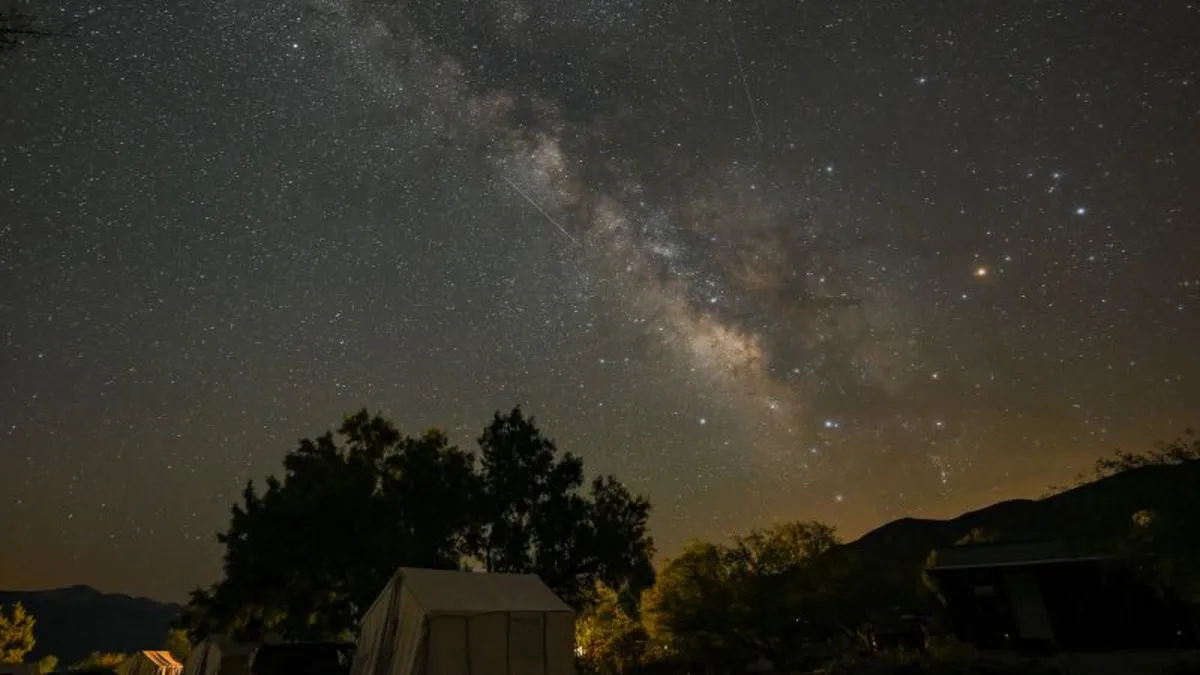
Sign up for CNN’s Wonder Theory science newsletter to explore the universe with captivating news about fascinating discoveries and scientific advancements. After several months without a meteor shower, sky-gazers finally have reason to celebrate as the Lyrids have arrived to kick off the season. These stunning meteors have been lighting up the sky since April 17 and will continue to dazzle until Saturday. According to the American Meteor Society, the densest concentration of meteors will occur from Monday night into Tuesday.
In a perfectly dark sky, onlookers can typically see up to 18 meteors per hour at the peak of the Lyrid shower. However, this year, the light from the waning crescent moon will make it somewhat challenging to view the celestial display. Weather permitting, those in the Northern Hemisphere can expect to witness around five streaking lights per hour between 10 p.m. local time on Monday and 4:30 a.m. on Tuesday. Dr. Bill Cooke, the lead for NASA’s Meteoroid Environment Office, emphasizes the importance of patience when observing meteors. "Most meteors you see during a Lyrid shower are not brilliant fireballs — they are faint little streaks," Cooke explains. "Moonlight tends to wash out those faint little streaks."
For the best viewing experience, Cooke recommends lying down outside in an area with minimal light pollution. Allow your eyes at least 30 minutes to adjust to the darkness. "Don’t look at your cell phone, because that bright screen destroys your night vision," Cooke warns. "And it takes your eyes off the sky."
The Lyrids are part of regular meteor showers that occur throughout the year as Earth passes through debris fields left by comets and asteroids. According to Shannon Schmoll, director of Abrams Planetarium at Michigan State University, the Lyrids originate from the parent comet C/1861 G1 (Thatcher), which is currently halfway through its approximately 415-year orbit around the sun. While Comet Thatcher was discovered in 1861, the Lyrids have been observed for an impressive 2,700 years, making them one of the oldest known meteor showers, as noted by NASA.
As the comet travels, it leaves a trail of ice and dust moving at thousands of miles per hour. When these meteors enter the Earth’s atmosphere, they slow down and generate heat, creating the flashes we see in the night sky. Astronomer Dean Regas explains, "Most of the material from meteor showers, the comet pieces, will burn up before they hit the ground, and a lot of them are about the size of a grain of sand. It’s astonishing to witness something so small light up the night."
While the Lyrids tend to be relatively consistent each year, they occasionally exceed expectations with outbursts of up to 100 meteors per hour, which occur unpredictably about every 60 years. The next significant outburst is anticipated around 2042, according to the American Meteor Society. The causes of these outbursts remain somewhat mysterious, but it is believed that the gravitational influences of other planets may affect the density of the debris as they cross paths.
If you miss the peak of the Lyrid shower, don't be discouraged! There are several other meteor showers to look forward to in 2025. Mark your calendars for these peak dates:
Eta Aquariids: May 5–6 Southern Delta Aquariids: July 29–30 Alpha Capricornids: July 29–30 Perseids: August 12–13 Draconids: October 8–9 Orionids: October 22–23 Southern Taurids: November 3–4 Northern Taurids: November 8–9 Leonids: November 16–17 Geminids: December 12–13 Ursids: December 21–22Following the recent pink moon event, there are eight more full moons to anticipate this year, including supermoons in October, November, and December. Here’s the list of remaining full moons in 2025, according to the Farmers’ Almanac:
May 12: Flower moon June 11: Strawberry moon July 10: Buck moon August 9: Sturgeon moon September 7: Corn moon October 6: Harvest moon November 5: Beaver moon December 4: Cold moonAs we approach the fall season, two significant eclipse events will grace the sky. A total lunar eclipse will be most visible from Europe, Africa, Asia, Australia, parts of eastern South America, Alaska, and Antarctica on September 7 and 8. A lunar eclipse occurs when Earth is positioned between the sun and the moon, causing the moon to pass into our planet’s shadow. During this event, the moon takes on a reddish hue, often referred to as a "blood moon," due to the shadow's diffusion of sunlight.
Additionally, a partial solar eclipse will take place on September 21, as the moon moves between the sun and Earth but the alignment is not perfect. This results in the moon blocking part of the sun’s face, creating a crescent shape that looks like the moon is taking a "bite" out of the sun. This event will be visible from parts of Australia, Antarctica, and the Pacific Ocean.